Comic book art runs the rainbow spectrum from realistic, to semi-realistic, to surrealistic, each time the metaphor getting stronger. In the surrealistic “toons” the world is populated by caricature humanoids and/or anthropomorphic fauna (‘funny animals”). Each of the four WECA publishers, except Educational Projects, had features that fell somewhere on the surrealistic end of this continuum.
Anglo American had Sooper Dooper by Jay McKellar and Les Gilpin in Three Aces Comics who was a sort of goofy, Canadian everyman always getting into jams.
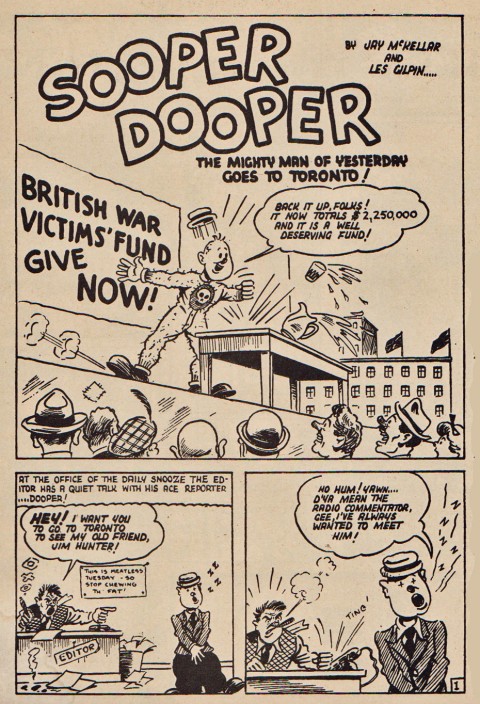
His counterpart for Maple Leaf was Bert Bushell’s Kipper Herring who appeared in early issues of Better Comics and perhaps the matching character for Bell Features was the least surrealistic of the bunch, Manny Easson’s Dizzy Don from The Funny Comics.
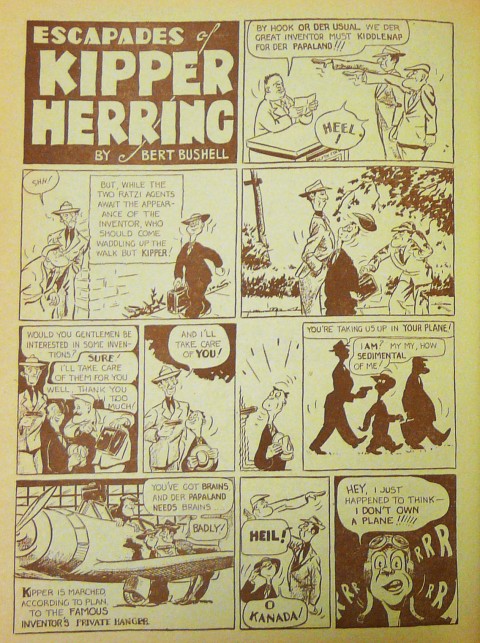
But these characters really aren’t “toonish” enough and to find the real “toons” you have to stick with Maple Leaf and especially Bell Features. The West Coast company had two great features in Jon Stables’ Piltdown Pete in Lucky Comics, and Bill Meikle’s Li’l Joe in Bing Bang Comics and his Nip, Zip and Flip feature in later issues of Better Comics.
Stables’ particular Paleolithic Peter, began in the Feb./March 1944 issue of Lucky Comics and harkened back a decade to V. T. Hamelin’s Alley Oop and shouted out forward a couple of decades to Hanna Barbera’s Fred Flintstone.
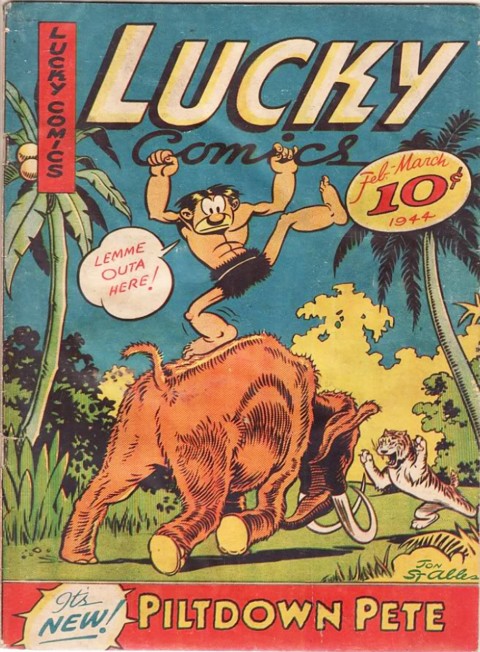
Stables had probably also come across Mal Eaton’s thirties British newspaper strip Peter Piltdown and taken off with his own idea. As always Stables’ illustrations are solid, fluid, and grounded with the ability to convey animation in static drawings and produced many great Lucky Comics covers featuring the character. Everybody in the strip was a toon except for a couple of the women such as Yot, who came from the tribe across the river, were knockout pinups who sometimes wore heels (like Al Capp’s Dogpatch females).
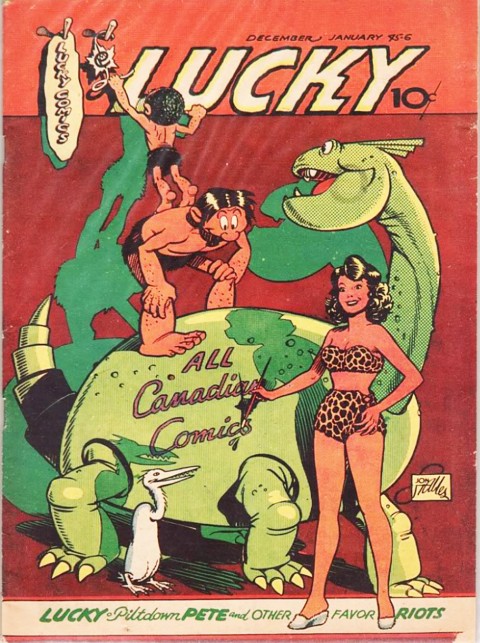
Jim Kelly has shown some great research on Pete and Jon Stables on his My Favourite Funnies site but is wrong in implying that the Piltdown Pete feature begins with the December-January 1944-5 issue of Lucky when the feature actually began almost a year earlier. He also makes an unwarranted assumption that the feature ends with the last Lucky issue of 1945, when there are a few 1946 Piltdown Pete stories in Lucky Comics as well as one in the very last issue of Rocket Comics No. 30 (Sept./Oct. 1946). Mr. Kelly also mistakenly indicates that Nip, Zip and Flip feature was done by Stables as well, when, in reality it was the work of Bill Meikle. Perhaps this is because Stables drew them whenever they appeared on the cover even though Meikle did the stories. Mr. Kelly’s accounting of the 1945 Piltdown Pete story line is still an excellent piece of research and work.
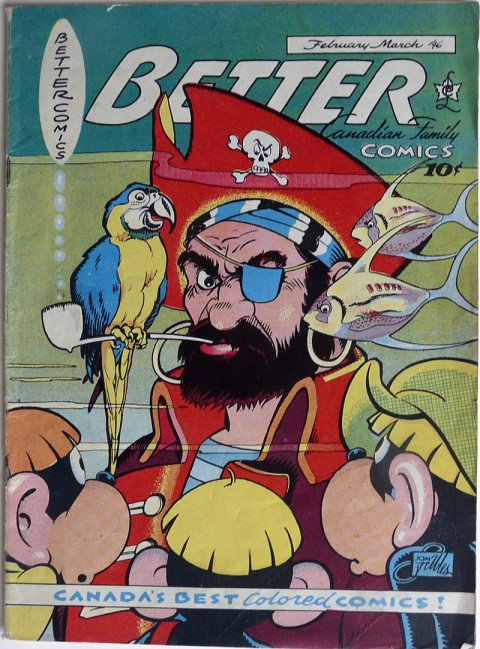
Bill Meikle was perhaps the best pure toonist in Canadian golden age comics. His three fingered creations, I think, stood above even Stables’ Piltdown Pete. His figures were rounder, clownier, drooping and and more balloon-figure-like in the best surreal sense. He seemed to come on board with Maple Leaf in the last year of production as Bing Bang Comics started to shift more to an emphasis on cartoony content and his Li’l Moe character started to earn more covers. This shift seemed to happen earlier towards the start of 1944 in Lucky Comics when Piltdown Pete started to get almost all of the covers. Maple Leaf seemed to be trying to capture a younger audience towards the end, at least in these two titles (this trend was echoed at Bell Features who started to reprint American funny animal stories under its title mastheads by the summer of 1946). By this time in the states as well the glory days of super heroes seemed to be setting and the time of funny animals, westerns, crime and teen/romance books were set to have their day and the Atom Age of graphic SF/horror books loomed on the next horizon.
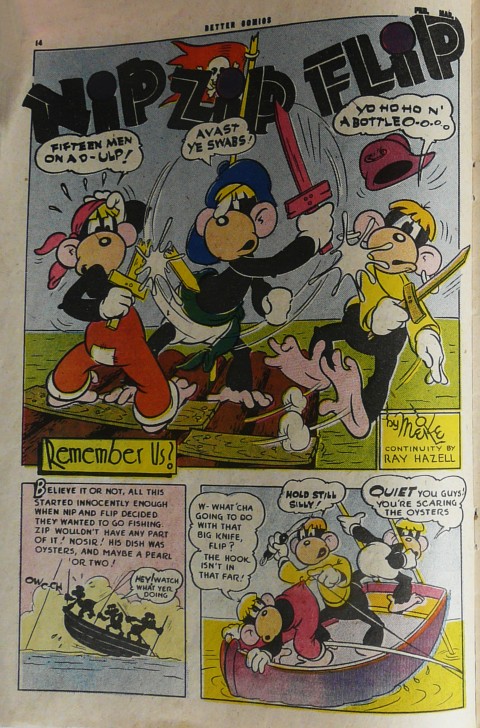
In the last year or so of Better Comics, Meikle had a feature called Nip, Zip and Flip which starred 3 monkeys stumbling in slapstick fashion through Three Stooges antics. During the last couple of issues of Rocket Comics, Meikle also had a feature called José Turkey and this was a serenading latino turkey in a sombrero riding around the old west just north of the Mexican border.
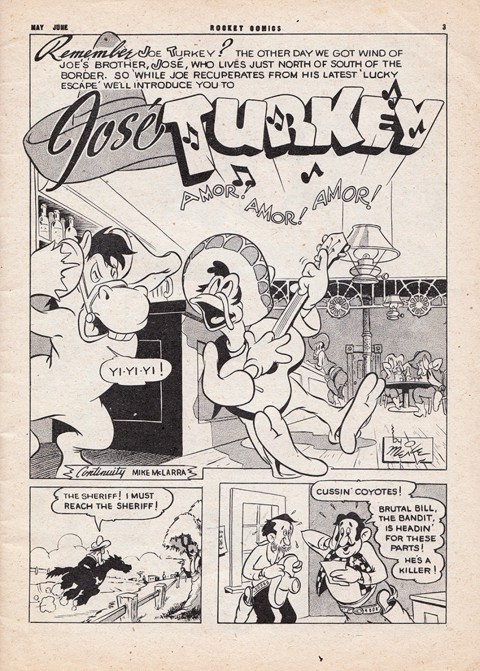
His signature feature, however, was Li’l Moe in Bing Bang Comics. Li’l Moe was a young black boy in a floppy hat with a sidekick pet dog called Scratch.
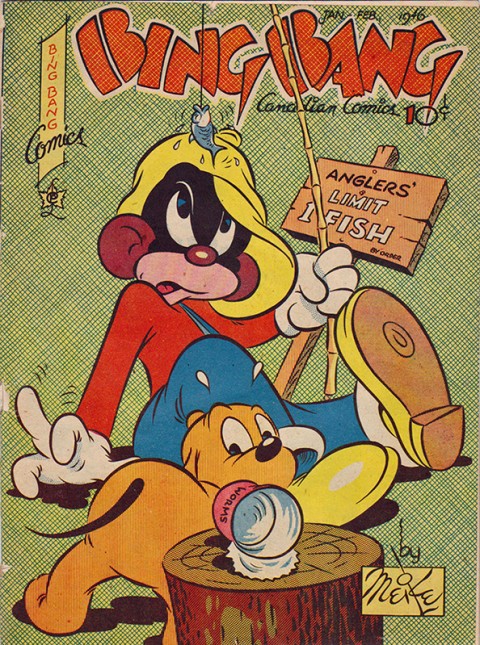
He isn’t inflicted with the disparaging Amos ‘n’ Andy vocabulary and intonation that most blacks were scripted with in golden age comics both in Canada and below the border though he is rendered as a caricature as most non-white characters were even though all the other characters in a story might be realistic but this is a cartoon type feature. Li’l Moe’s adventures often result in a criminal being flushed out and captured by the police due to Li’l Moe’s blundering about.
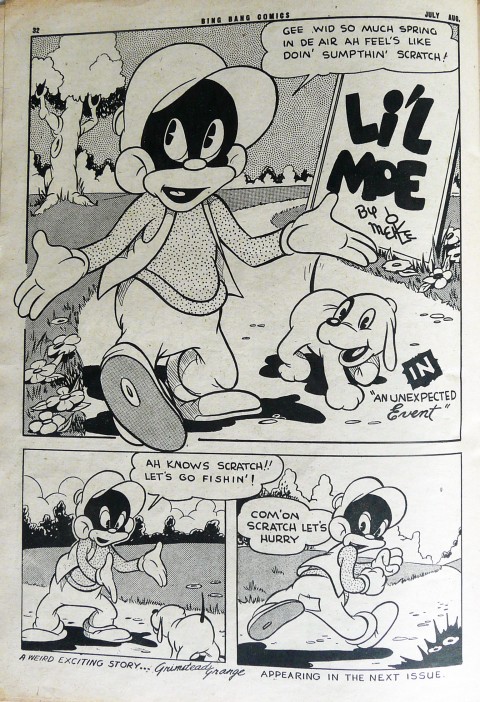
I don’t exactly which issue of Bing Bang Comics Li’l Moe first appeared in, but again he was a post war creation of Bill Meikle and typical of that move toward funny animal books that WECA books tried while thrashing for survival in
This post begs at least three more follow-ups.
- The toon features in Bell WECA books.
- The numbering and dates of Maple Leaf books, especially in that confusing last year.
- Racial caricature of blacks, orientals, and North American aboriginals in WECA books. (This one would be the hardest and most delicate to do but screams for attention.)
Any votes for one above the others?




I think you are correct and #3 tops the list of topics that a important for discussion.
While we can all blame the war as being partially responsible for some of the acceptance of caricatures some of it was due simply to the era it occurs in.
Blacks were not the enemy in #3’s list but were “acceptable” in that era to be objectified in that way.
Their heroic participation in WWII probably helped lead them into the long overdue equal rights movements that followed that makes that not acceptable today,
The topic definitely deserves attention, especially with the upcoming release of reprints because the current generation is far removed from what it was like 70 years ago when WECA books were created.
RE: #2
The largest collector of Maple Leaf books who lives in BC can shed some light on their history.
Let me know if you need contact information.
Thanks for your thoughtful comment Jim. The examination of racially inappropriate caricatures of non-white individuals in the WECA books is something I want to get around to but it’s a mine field that is daunting.
I do want to look at that crazy last year of Maple Leaf books soon though and will take you up on your contact out west.